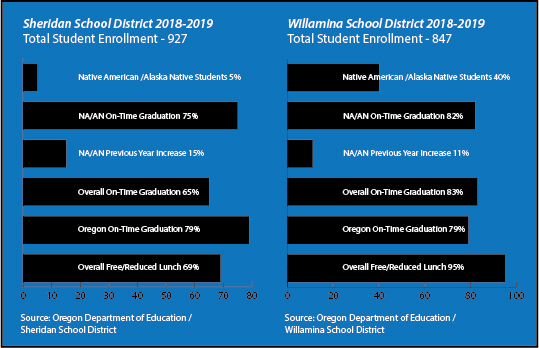Health & Education
On-time graduation rates increasing for Native American students

By Danielle Frost
Smoke Signals staff writer
The number of Native American students graduating high school within four years has increased in the Willamina and Sheridan school districts.
Willamina saw an 11-percent increase, from 71 percent in 2018 to 82 percent in 2019. Approximately 40 percent of the Willamina student population identifies as Native American/Alaska Native.
In Sheridan, the number increased from 60 percent in 2018 to 75 percent in 2019. Overall, the district has 5 percent Native American/Alaska Native students.
The graduation information was a part of Oregon’s annual school report card, which provides a snapshot of the state’s education system and includes data about students, teachers and schools. Statewide, the overall four-year graduation rate for all students is 78.7, with minority students at 73 percent.
“We had one of the best (increases) in the state,” says Willamina School District Superintendent Carrie Zimbrick. “I would attribute this to the extra effort staff made to ensure students were completing the needed credits to get their diploma.”
Sheridan School Superintendent Steven Sugg says the district has worked during the past two years to build stronger relationships with the Tribe.
For example, teachers and administrators meet several times a year to discuss student progress and how to best support each student. In January, the Tribe’s Education Department will speak at assemblies at Faulconer-Chapman and Sheridan High School.
“We are planning events to educate all of our students about Tribal traditions and helping them feel comfortable and supported in our schools,” Sugg says.
Historically, on-time graduation rates for Native Americans and Alaska Natives have lagged behind white students, but this is changing.
“Overall our (Native) students have performed relatively equal to all other subgroups,” Zimbrick says. “I would point out the strong investment the (Grand Ronde) Tribe has made in education overall: Quality preschool programs, afterschool programs, tutors during the school year and summer programs.”
She notes that Willamina High School’s Life Education for Alternative Directions also has been instrumental.
“Mrs. (Heather) Hughes, who runs our alternative education program has done an amazing job building relationships with students in her program,” Zimbrick says. “She has helped students that are credit deficient get back on track and graduate.”
Willamina has three goals district-wide to improve graduation outcomes for all students. These are focusing on core academics such as math and reading, improving school culture by creating an atmosphere where students are cared for and want to attend class, and addressing equity concerns by defining what it means and how current policies and procedures have an effect.
“Graduation is the most important goal for all students and it begins in kindergarten,” Zimbrick says. “We know we must support students from day one upon entering our schools.”
To encourage on-time graduation, the district developed an “early warning system” of monitoring attendance, behavior and course performance. The district also has placed emphasis on the career technical education options, and notes that students who participate in those classes have a higher graduation rate.
“Last year our CTE participants had a graduation rate of 97 percent and our CTE completers who take five or more classes had a 100-percent graduation rate,” Zimbrick says.
Studies have shown that proper nutrition has a direct effect on school performance. In Willamina, more than 95 percent of the student population receives free and reduced lunches.
“Poverty is definitely a challenge, but it is possible to be a high poverty and high performing district,” Zimbrick says. “We know we need to meet basic needs in order to educate our students. We feed students four to five times a day at no cost to any student, offer school supplies and clothing as needed, and most importantly build relationships that are genuine and caring.”
